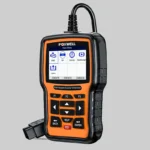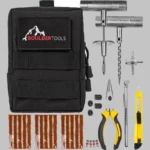A torque wrench is an essential tool in the automotive industry, known for its ability to apply a specific amount of torque to a fastener, such as a nut or bolt. This precision helps ensure that the fastener is neither too tight nor too loose, maintaining the integrity and safety of the vehicle’s mechanical connections. The importance of using the correct tools for vehicle maintenance cannot be overstated, as it ensures not only the longevity of the vehicle but also the safety of its occupants and other road users.
Understanding Torque Wrenches
At its core, a torque wrench is a tool designed to precisely apply a specific torque to a fastener. There are several types of torque wrenches available, each suited to different tasks:
1. Manual Torque Wrenches
These are the most common types used in automotive settings. They typically feature a dial or a scale that indicates how much torque is being applied. Users adjust the torque manually until the desired setting is reached.
2. Pneumatic Torque Wrenches
Used for high-torque applications, these wrenches are powered by compressed air and are common in professional automotive workshops. They are especially useful for tasks that require consistent torque application over multiple fasteners, such as in engine assembly.
3. Electronic Torque Wrenches
These provide digital readouts of torque and are highly accurate. They are beneficial in precision mechanics where exact torque specifications are crucial for safety and functionality.
Each type of wrench has its place in automotive maintenance, depending on the precision required and the nature of the task.
The Role of Torque Wrenches in Automotive
Torque wrenches play a critical role in both the assembly and maintenance of vehicles. Manufacturers specify the exact torque values for almost every fastener in a vehicle to ensure optimal performance and safety. Applying incorrect torque can lead to several problems:
- Under-torquing might cause fasteners to loosen over time, leading to parts becoming detached, which can severely compromise vehicle safety and operation.
- Over-torquing can strip threads or break fasteners, which also compromises the assembly and can lead to costly repairs or dangerous failures, especially at high speeds or under heavy loads.
The controlled application of torque is particularly important in components such as the engine or wheel assemblies, where precise torque specifications are crucial for safety and efficacy.
Benefits of Using Torque Wrenches
Using a torque wrench in automotive maintenance offers several key benefits:
- Accuracy: Ensures that all fasteners are tightened to the manufacturer’s specified torque, reducing the risk of part failure due to improper tightening.
- Consistency: Especially with pneumatic and electronic wrenches, torque application is consistent across multiple fasteners, essential in tasks like engine building where each bolt’s torque needs to match exactly.
- Safety: Properly torqued fasteners are less likely to fail, thereby enhancing the safety of the vehicle by preventing wheels or other critical components from coming loose.
Selecting the Right Torque Wrench
Choosing the right torque wrench involves several considerations:
- Type of Vehicle: Larger vehicles and those that handle heavy loads might require a torque wrench capable of delivering higher torque values, typically found in pneumatic models.
- Maintenance Frequency: For professional settings where tools are used frequently and on various types of vehicles, a more durable and versatile tool, like an electronic torque wrench, might be more cost-effective.
- Torque Requirements: The specific torque requirements of the vehicle must be met. This means selecting a wrench that can accurately deliver within the required torque range. Manual wrenches often suffice for lighter cars, but heavier vehicles might need the robustness of pneumatic or electronic wrenches.
How to Use a Torque Wrench Correctly
Using a torque wrench correctly is vital for ensuring the safety and longevity of automotive components. Here is a step-by-step guide on how to properly use a torque wrench in automotive applications:
- Select the Correct Wrench: Choose a torque wrench that matches the required torque specification for the task at hand. Ensure that the wrench can handle the torque range specified for the fasteners being used.
- Check Calibration: Before use, check that the torque wrench is correctly calibrated. An incorrectly calibrated wrench can lead to under- or over-tightening, which may damage the vehicle or affect its safety.
- Set the Torque Value: Adjust the torque wrench to the specific torque value recommended by the vehicle manufacturer. This is usually found in the vehicle’s service manual. For adjustable wrenches, set the dial to the correct torque; for digital wrenches, input the desired torque on the digital interface.
- Secure the Fastener: Place the wrench on the fastener and ensure it fits snugly. Misalignment can cause the tool to slip and damage the fastener or alter the torque applied.
- Apply Steady Pressure: Apply pressure in a slow, steady manner to the wrench handle at the midpoint to ensure even application of force. Avoid jerky or sudden movements that can lead to inaccurate torque application.
- Listen for the Click: Most manual torque wrenches click when the preset torque is reached. Stop applying force immediately when you hear this click to avoid over-tightening.
- Double Check: Once tightened, it’s a good practice to remove the wrench and then reapply it to double-check the torque. This ensures that the fastener is properly tightened.
- Reset the Wrench: After use, reset the torque wrench to zero or the lowest setting. This helps relieve tension in the spring, maintaining the accuracy and longevity of the tool.
Common Mistakes to Avoid
When using a torque wrench, certain common mistakes can lead to mechanical failures or safety issues:
- Over-tightening: Beyond the click or specified torque can strain or snap bolts and studs.
- Under-tightening: Not applying enough torque can lead bolts to loosen under vibration, risking disassembly.
- Using as a Breaker Bar: Using a torque wrench to break free stuck fasteners can damage the calibration mechanism.
Torque wrenches are indispensable tools in automotive maintenance, crucial for applying precise force on fasteners to ensure vehicle integrity and safety. Selecting the right torque wrench, using it correctly, and maintaining its calibration are critical for any automotive professional or enthusiast. Always refer to the manufacturer’s specifications for torque settings and ensure regular maintenance of your torque tools to keep them in optimal working condition. This adherence to precision not only extends the life of the vehicle but also safeguards those who rely on its performance daily.

Matthew Dowell
Matthew, a seasoned builder from a family of craftsmen, leads Tools Trove. His passion for tools and decades of hands-on experience fuel his commitment to providing expert reviews and insightful content. Whether you’re a pro or a DIY enthusiast, Matthew’s guidance ensures informed decisions in the world of tools.




